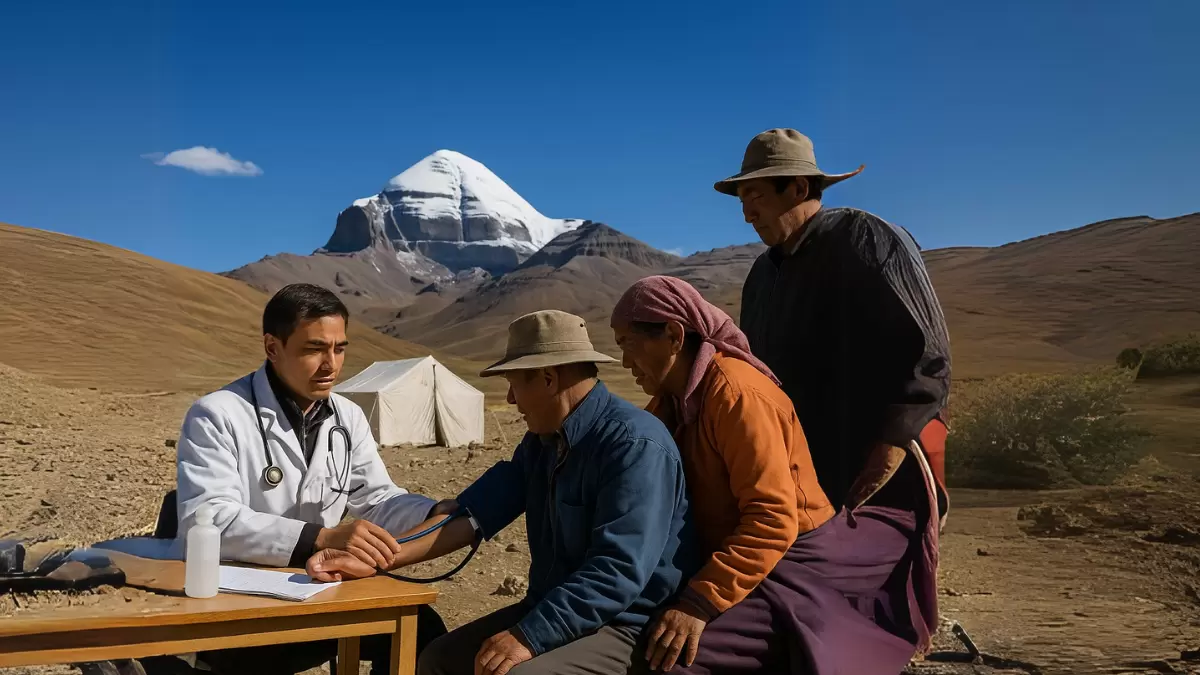The Kailash Yatra is one of the most revered spiritual pilgrimages where thousands of devotees from India and across the globe undertake this arduous journey to the remote Himalayan region of Tibet to witness Mount Kailash. While the journey offers deep spiritual fulfillment, it also presents significant physical and logistical challenges due to high-altitude terrain, unpredictable weather, and limited infrastructure.
To ensure the safety and wellbeing of pilgrims, health camps at key points like Saga Manasarovar, and Darchen have become critical. These camps offer not just emergency medical service but also proactive care and monitoring that can make the difference between life and death in extreme environments.
Our Mission: Health with Devotion
Mount Kailash is not just a mountain but also symbol of cosmic power and spiritual unity and the 52-km Kora or circumambulation around Mount Kailash is considered to cleanse one’s sins and bring spiritual liberation.
Pilgrims usually reach the area via Nepal and China. After entering Tibet, the key halts include Saga, Manasarovar Lake, and Darchen, which is the base from where the Kailash Kora begins. These high-altitude zones are not only beautiful but also potentially hazardous due to hypoxia (low oxygen levels), Acute Mountain Sickness (AMS), and exposure to freezing weather.
The Parikarma of Mount Kailash is considered a sacred act of penance; the 52-kilometer circuit takes pilgrims across rugged, high-altitude terrain, including the Dolma La Pass-the most arduous segment of the trek.
The High-Altitude Challenge: Physical and Medical Risks
The Kailash yatra often begins in Kathmandu, and after crossing the Nepal-China border, pilgrims precede Tibet via mountainous terrain. Upon reaching the Tibetan Plateau, travelers face sudden altitude gains, with many locations exceeding 4500 meters.
At such altitude, the human body can suffer from Acute Mountain Sickness (AMS), which includes symptoms like headache, dizziness, nausea, fatigue, and even life-threatening conditions like High Altitude Pulmonary Edema (HAPE) or High Altitude Cerebral Edema (HACE). The cold weather, oxygen deprivation, and lack of medical facilities in remote areas further exacerbate the risks.
Recognizing these challenges, several health camps are strategically set up at Saga, Manasarovar, and Darchen to monitor the health of pilgrims and provide emergency medical assistance when required.
Health Camp Highlights
1. Saga: The Acclimatization Hub
Saga is the first major town where pilgrims rest after entering Tibet. This place is situated at around 4600 meters above sea level; it is a crucial stop for acclimatization. Health camps here focus on preventive care: checking oxygen saturation, providing medication for acute mountain sickness (AMS), and monitoring high-risk individuals such as the elderly and those with underlying health conditions. Common treatments include oxygen therapy, hydration support, and distribution of essential medicine like Diamox (for AMS) and antibiotics for respiratory infections.
2. Manasarovar: Sacred Waters, Watchful Care
Lake Manasarovar is the gem and a sacred lake where people take a ritual bath and perform prayers. However, this is also where the body is pushed to its edge. Exposure to freezing waters, strong UV radiation, and high winds often results in hypothermia, dehydration, and eye issues.
Health camps near Manasarovar are typically more robust during peak pilgrimage season. Equipped with oxygen concentrations, emergency medical kits, and trained staff, these camps are essential for immediate care. Medical professionals here provide both curative and preventive service, for treating infection to educate pilgrims on conserving energy and maintaining hydration.
Importantly, these health stations also provide emergency evacuation support, coordinating with local Chinese authorities and helicopter service for those in need of urgent care in lower altitudes or specialized hospitals.
3. Darchen: Gateway to the Parikrama
Darchen is the final staging ground before the demanding three-day Kailash Kora. At nearby 4675 meters, Darchen marks the last place where motor vehicles can reach. From here, pilgrims embark on a physically intense trek, which involves crossing the Dolma La Pass, the highest point on the route.
The health camp at Darchen is critical. It serves as a screening point-pilgrim undergoes health assessment to determine if they are fit to attempt the Parikarma. Here, the medical team provided detailed briefing on what to expect during the trek, signs of altitude-related issues, and what to do in case of emergency.
Many pilgrims suffer from altitude-related fatigue, joint pain, and breathlessness. Darchen’s medical stations not only offer treatment but also distribute portable oxygen cylinders and ensure that communication systems are in place in case of mid-Parikarma emergency.
Touching Lives, One Pilgrim at a Time
Every year, hundreds of yatris benefit from our health interventions. For many, a timely dose of oxygen or a night of monitored care is what allows them to complete the yatra and return safely. Our work is driven by compassion, service, and a deep respect for the sacredness of this pilgrimage.
Conclusion: A Sacred Journey Made Safer
The Kailash Manasarovar Yatra is one of the most spiritually enriching and physically demanding pilgrimages, where pilgrims traverse through high-altitude deserts, glaciers, and sacred waters, their resilience is constantly tested. The presence of well-organized health camps at Saga, Manasarovar, and Darchen is not just a medical necessity-it is a lifeline that allows thousands to complete the yatra each year.
In many ways, the camps represent the intersection of faith and science, where ancient devotion meets modern medicine. As more yatris undertake this sacred journey every year, the continued support and enhancement of these health services will be essential to keeping the spirit of the Kailash Yatra alive and safe.
Join Us in Service!
We welcome volunteers, medical professionals, and donors to become part of this noble initiative. With your support, we can expand our reach, upgrade our equipment, and continue ensuring that every yatri receives the care they deserve.
Together, let us make every step of the Kailash Yatra a little safer, a little easier, and a lot more meaningful.

